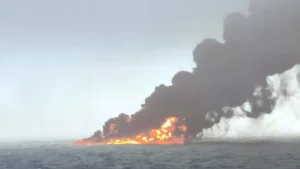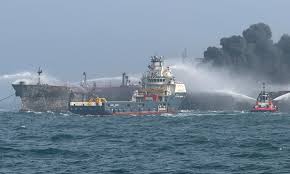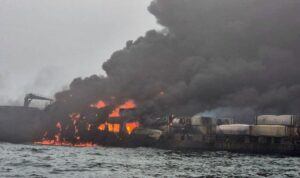
On the morning of March 10, 2025, a significant maritime incident occurred in the North Sea near the Humber estuary off the eastern coast of England. The U.S.-flagged oil tanker MV Stena Immaculate, under a short-term charter to the U.S. Navy’s Military Sealift Command and carrying approximately 35 million liters (18,000 tonnes) of Jet A-1 fuel intended for the U.S. Department of Defense, was anchored when it was struck by the Portuguese-flagged cargo vessel MV Solong, which was transporting 15 containers of toxic sodium cyanide.

The collision, occurring around 10:00 AM local time, resulted in multiple explosions and a substantial fire aboard the Stena Immaculate. The impact breached one of the tanker’s cargo tanks, leading to a spill of jet fuel into the North Sea. Agency, involving helicopters, lifeboats, and firefighting vessels. Out of the 37 crew members from both ships, 36 were rescued, with one individual hospitalized; however, one crew member from the Solong remains missing after an extensive search was called off.

Environmental concerns have escalated due to the potential impact of the jet fuel spill and the hazardous cargo aboard the Solong. Experts have expressed apprehension about the spill’s effect on local wildlife, including bird colonies, seals, dolphins, and porpoises in the area. Dr. Paul Johnston, a senior scientist at the Greenpeace laboratories at the University of Exeter, highlighted the risk to these species, noting that prevailing northerly winds could drive the spilled fuel toward the north Norfolk coast, an Area of Outstanding Natural Beauty. Additionally, the presence of sodium cyanide on the Solong raises further environmental and safety concerns, given the chemical’s high toxicity.

Authorities are actively monitoring air and water quality to assess the environmental impact. The Maritime and Coastguard Agency is conducting ongoing pollution assessments, and marine accident investigators from the UK, US, and Portugal are examining the cause of the collision. Factors under investigation include potential navigation errors, autopilot issues, and the dense fog reported at the time of the incident.
The incident has also raised alarms regarding the safety protocols for transporting hazardous materials through ecologically sensitive areas. Local authorities and environmental agencies are preparing for potential cleanup and containment measures to mitigate the spill’s impact on marine life and coastal ecosystems. The situation remains dynamic, with ongoing efforts to control the fires, contain the spill, and investigate the collision’s root causes to prevent future occurrences.








